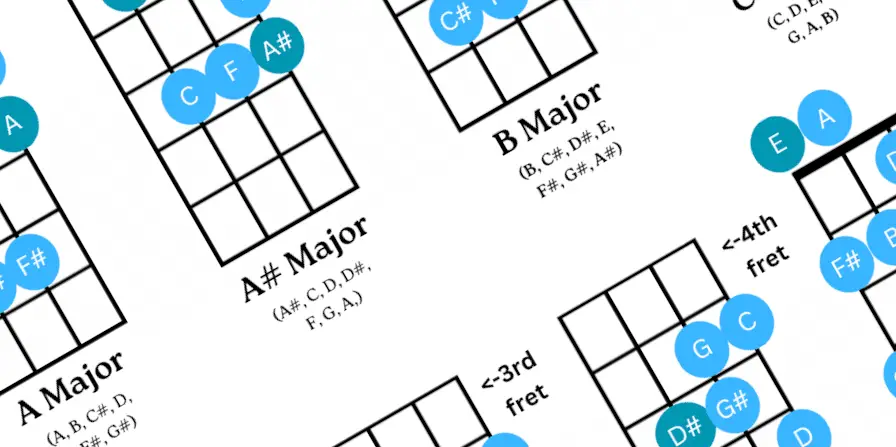The major scale was the first scale I learned to play on the bass. I still remember how it wasn`t that difficult to learn. However, in hindsight, I didn`t understand much about what made the scale important. The learning materials I used thus made it much harder to understand the scale than it needed to be.
As I`ve learned quite a bit about the 4-string in the past 16 years, I thus decided to make my own guide to major scales on the bass.
It will help you learn the major scale in a quick and easy manner and explain what makes it so important. You will also learn how to play it in any key with the help of some easy-to-use infographics. Lastly, I`ve also added a list of some popular bass lines in major scales.
Major scale steps
Every single scale is made out of steps, and the major scale is no exception. Steps make up the relation between the notes of the scale. This relation between the notes is what gives the major scale its distinct sound.
The scale steps are also the same across all major scales. In other words, the steps in A major, E major, and F major are the same.
The major scale only consists of two types of steps: whole-steps and half-steps. The concept of half and whole steps is best illustrated when played on a single string of the bass. For example, here is what the E Major scale looks like when played solely on the E-string:

The half-steps are right next to the last note of the scale. For example, A is a half-step above G#.
The whole steps skip a fret. For example, F# and G# are a whole step apart as the fret in between them, G, is skipped.
Therefore, the major scale never skips more than 1 fret at a time. This makes the major scale easier to remember, as you simply have to memorize a pattern of half and whole steps.
As mentioned, this pattern is the same regardless of the key of the major scale. To illustrate this, here is A Major played solely on the A-string of the bass:

E Major and A major sound different in pitch but share the same major scale characteristics. The changes in pitch between major scales lead to small differences in how it feels to listen to them. Because of this, you might sometimes find it natural to transpose bass lines from one major key to another.
Lastly, here is a universal cheat sheet for the pattern of the steps. This table works for playing any major scale on the bass. If you start on an “A” note and follow the steps, you will play an A major scale. If you start on a “B” note, you will instead play a B Major scale.
| Scale degree: | Steps up from the note below it: | Interval to root note: |
| 1 | N/A | N/A |
| 2 | Whole-Step | Major Second |
| 3 | Whole-Step | Major Third |
| 4 | Half-Step | Perfect Fourth |
| 5 | Whole-Step | Perfect Fifth |
| 6 | Whole-Step | Major Sixth |
| 7 | Whole-Step | Major Seventh |
| 8 | Half-Step | Octave |
How to play every major scale on the bass
Now that you know the pattern of the notes that make up the major scale, let`s look at how the major scale differs between keys.
For example, the G major and D major scales both share the same pattern. However, the pattern starts at different spots on the fretboard. Thus, there is an infographic that shows how to play every single major scale on the bass guitar.
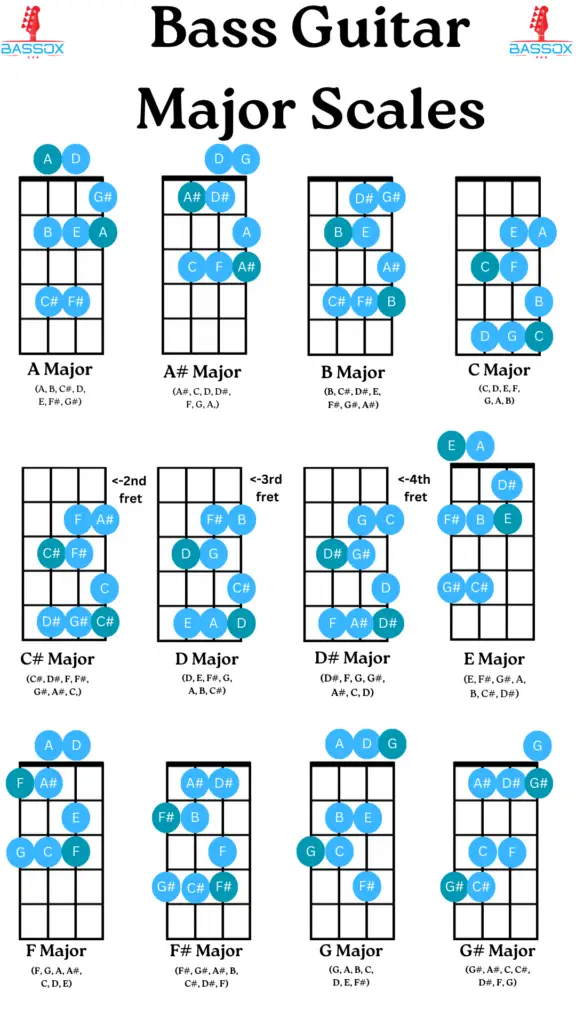
Note also that these examples show how to play one octave of the major scale. In other words, each of these illustrations shows how to play the scale in full, going through every note of it.
With that said the pattern of the major scale continues to repeat itself after spanning an octave. For example, here is every note that is part of the A major scale on the first 4 frets:
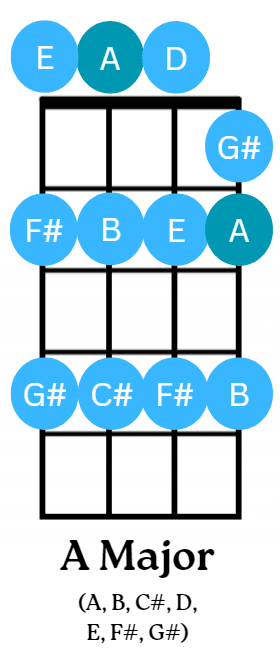
For beginners, I recommend focusing on learning how to play the different major scales, spanning 1 octave. Then, as you become more comfortable with the pattern, start practicing the scales beyond the octave and the root note.
Once you memorize the scales, I recommend learning how to use them for playing triads. Triads are chords that make use of 1., 3., and 5. steps of the scale. To learn more, check out this bass chords chart.
Bass Lines in The Major Scale
While you will find songs written in every type of major key, some of them are more common than others.
Namely, songs that are centered around or written on the bass or the guitar are often played in E and A major. This is mainly because the first two strings of both instruments are tuned to E and to A, making them intuitive keys for writing songs.
You will also commonly find bass lines in C major. C is a more common key in music centered around the piano.
On the piano, C Major can be played using only using the white keys. This makes it an easy key to writing songs in and you will commonly find it in children’s songs as well as a multitude of common genres.
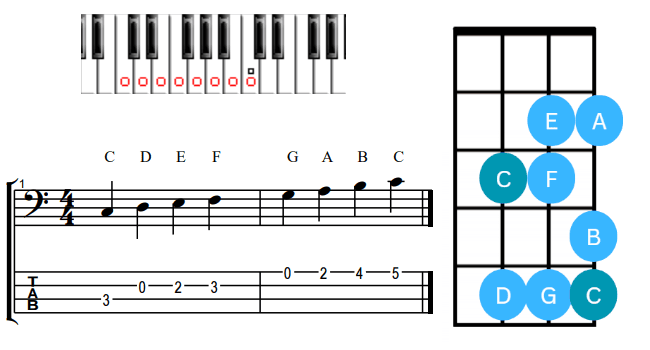
While the major scale has seen been used in various emotional contexts, it is generally regarded as a happy and upbeat scale.
It is often thought of as the happy counterpart to the minor scale which is regarded as sad. This is partly true. When you hear a happy song, chances are good that it is written in a major key.
However, there are many exceptions to this rule, and being written in a major key does automatically make a song sound happy. For example, Pink Floyd`s Wish You Were Here and Eric Clapton`s Tears In Heaven are both great examples of melancholy songs in major keys.
Another example is Iron Maiden`s Number Of The Beast. This song shows that in the metal genre where even happy songs tend to be written in a minor key, the major scale can make for an anthemic and powerful song.
| Band: | Bass Player: | Song in Major key: |
| Toto | David Hungate | Africa (A Major) |
| The Beatles | Paul McCartney | Here Comes The Sun (A Major) |
| The Clash | Paul Simonon | Should I Stay or Should I Go (D Major) |
| Blink-182 | Mark Hoppus | All The Small Things (C Major) |
| The Police | Sting | Every Breath You Take (G# Major) |
| Jackson 5 | Wilton Felder | I Want You Back (Ab Major) |
| Eric Clapton | Nathan East | Tears In Heaven (A Major) |
| Iron Maiden | Steve Harris | The Number Of The Beast (D Major) |
| Pink Floyd | Roger Waters | Wish You Were Here (G Major) |
| ABBA | Rutger Gunnarsson | Dancing Queen (A Major) |
Scale degree names
Some musicians like calling different notes off a scale by the name of their degree. The degree is a different name for a step of a scale that tells us what its harmonic function is.
Here is an infographic that details the names of the different degrees of the major scale. It also lists C, E, and F Major as examples of what notes you will find at the different degrees of these scales.
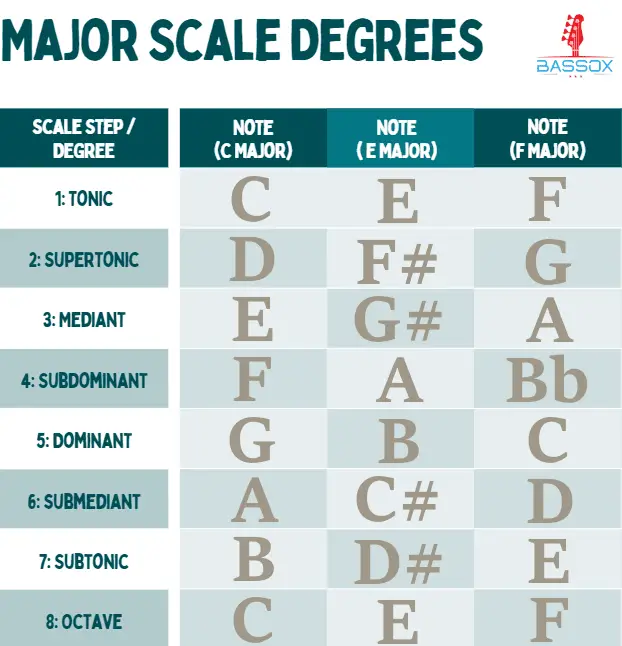
For those of you coming from a theoretical background, you might find using degrees helpful for memorizing major scales.
If degrees are completely new to you, don`t worry. For the most part, you can use the numbered steps of the scale just as well as their degree name to memorize them. However, I recommend memorizing the following 3-degree names, as they are commonly used across all genres:
- Tonic = 1. Step = Root Note
- Subdominant = 4. Step = Perfect Fourth
- Dominant = 5. Step = Perfect Fifth
Bassists who play theory-heavy genres like classical or jazz will run into degree names quite often. For most other genres, it is not as crucial to memorize all the degree names.
However, do remember that degree effectively just means the same thing as scale steps, as this will save you from some unneeded confusion sooner rather than later.
Conclusion
While learning scales on the bass guitar can seem overwhelming at first, there really isn`t that much to it if you go about it the right way.
Start out by memorizing the pattern of the major scale. The major scale will always have the same pattern of whole steps and half-steps regardless of what key you play it in.
Then, apply the pattern you`ve learned to different major scales until you can play F major just as easily as A Major. For help with this, you might want to save or print out the infographic in this guide.
The next step is to practice the major scale beyond 1 octave and use it to play chords. Lastly, you can apply all you have learned to cover famous bass lines in the major key and even write new bass lines of your own.

